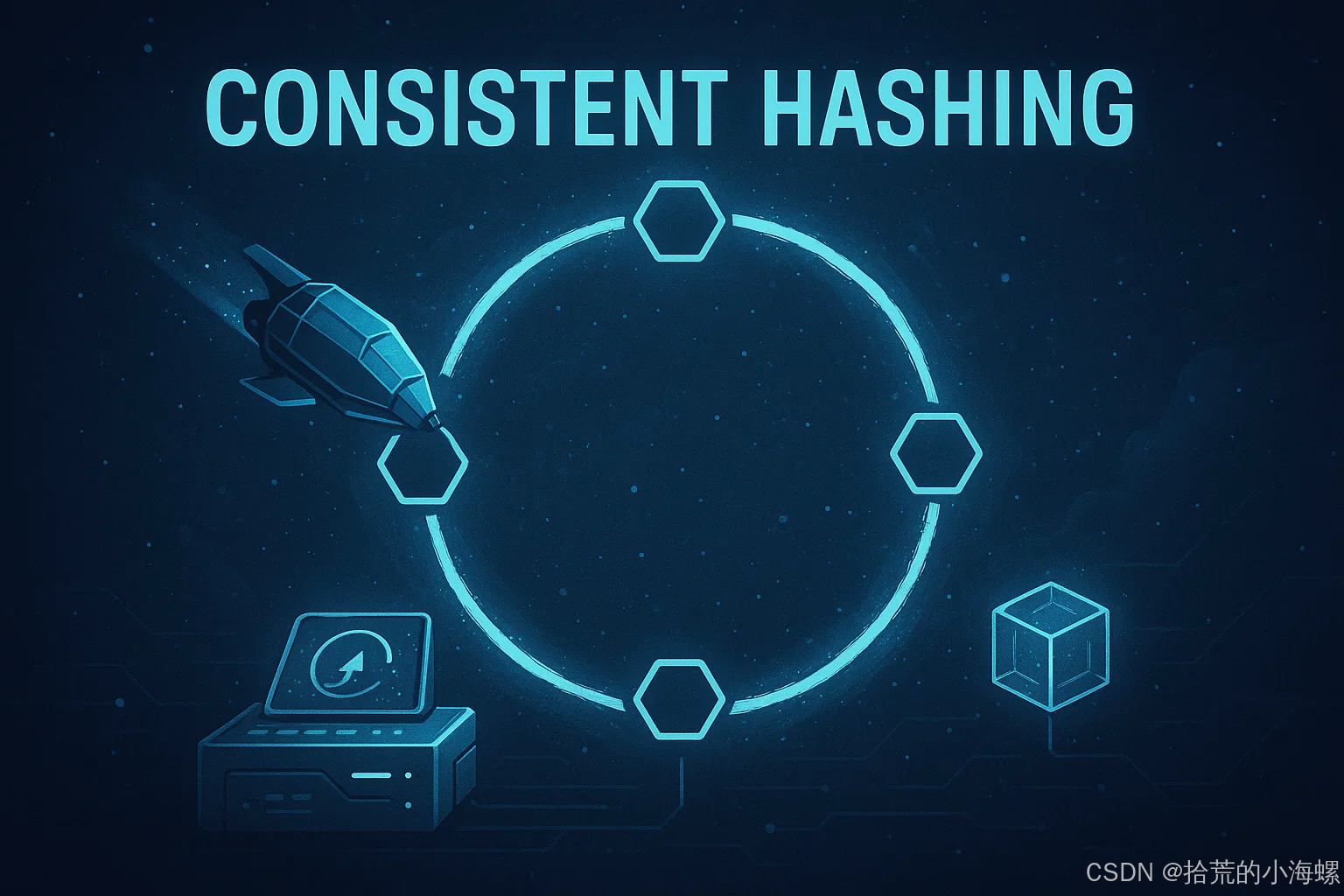1、简述
在分布式系统中,负载均衡和数据分片是核心问题。传统的取模方式(hash(key) % N)虽然简单,但当节点数量变化时,会导致 大规模数据迁移。
为了解决这一问题,引入了 一致性哈希算法(Consistent Hashing)。它可以在节点变化时,仅影响部分数据映射,大大降低系统的抖动和迁移开销。

2、一致性哈希的核心思想
🔹 将哈希空间抽象成一个 环(0 ~ 2³²-1);
🔹 将节点(例如缓存服务器)映射到环上;
🔹 数据(key)通过哈希函数映射到环上,顺时针找到最近的节点作为归属;
🔹 当节点增减时,只会影响该节点相邻区间的少量数据。
直观对比
🔹 取模法:节点数变化 → 所有数据几乎都要重新分布。
🔹 一致性哈希:节点数变化 → 只有少部分数据需要迁移。
虚拟节点
为了避免数据分布不均,一致性哈希中常引入 虚拟节点(Virtual Node) 概念:
🔹 每个真实节点对应多个虚拟节点;
🔹 数据实际映射到虚拟节点,再归属于真实节点;
🔹 提升数据分布均匀性,避免“倾斜”。

3、实践样例
3.1 定义一致性哈希类
import java.nio.charset.StandardCharsets;
import java.security.MessageDigest;
import java.util.*;
public class ConsistentHash<T> {
private final HashFunction hashFunction;
private final int numberOfReplicas; // 每个节点的虚拟节点数
private final SortedMap<Integer, T> circle = new TreeMap<>();
public ConsistentHash(HashFunction hashFunction, int numberOfReplicas, Collection<T> nodes) {
this.hashFunction = hashFunction;
this.numberOfReplicas = numberOfReplicas;
for (T node : nodes) {
add(node);
}
}
// 添加节点(含虚拟节点)
public void add(T node) {
for (int i = 0; i < numberOfReplicas; i++) {
circle.put(hashFunction.hash(node.toString() + i), node);
}
}
// 移除节点
public void remove(T node) {
for (int i = 0; i < numberOfReplicas; i++) {
circle.remove(hashFunction.hash(node.toString() + i));
}
}
// 获取 key 对应的节点
public T get(Object key) {
if (circle.isEmpty()) {
return null;
}
int hash = hashFunction.hash(key);
if (!circle.containsKey(hash)) {
SortedMap<Integer, T> tailMap = circle.tailMap(hash);
hash = tailMap.isEmpty() ? circle.firstKey() : tailMap.firstKey();
}
return circle.get(hash);
}
// 简单的 MD5 哈希实现
public interface HashFunction {
int hash(Object key);
}
public static class MD5Hash implements HashFunction {
@Override
public int hash(Object key) {
try {
MessageDigest md = MessageDigest.getInstance("MD5");
byte[] digest = md.digest(key.toString().getBytes(StandardCharsets.UTF_8));
return ((digest[3] & 0xFF) << 24) | ((digest[2] & 0xFF) << 16) |
((digest[1] & 0xFF) << 8) | (digest[0] & 0xFF);
} catch (Exception e) {
throw new RuntimeException(e);
}
}
}
}
3.2 使用示例
import java.util.Arrays;
public class ConsistentHashDemo {
public static void main(String[] args) {
ConsistentHash<String> consistentHash =
new ConsistentHash<>(new ConsistentHash.MD5Hash(), 100,
Arrays.asList("NodeA", "NodeB", "NodeC"));
// 模拟分配 10 个 key
for (int i = 1; i <= 10; i++) {
String key = "key" + i;
String node = consistentHash.get(key);
System.out.println(key + " is mapped to " + node);
}
// 模拟 NodeC 宕机
System.out.println("\n---- Remove NodeC ----");
consistentHash.remove("NodeC");
for (int i = 1; i <= 10; i++) {
String key = "key" + i;
String node = consistentHash.get(key);
System.out.println(key + " is mapped to " + node);
}
}
}
3.3 运行效果
添加三个节点时:
key1 is mapped to NodeB
key2 is mapped to NodeA
key3 is mapped to NodeC
...
移除 NodeC 后:
key3 is mapped to NodeB
key4 is mapped to NodeA
...
👉 可以看到,只有 部分 key 从 NodeC 迁移到了 NodeA/NodeB,而不是全部数据重新分配。
4、应用场景
🔹 分布式缓存(Redis、Memcached 集群):缓存 key 的分布与扩缩容。
🔹 分布式存储(HDFS、Ceph):文件块分布在不同存储节点。
🔹 消息队列(Kafka 分区):消息的分区分配。
🔹 API 网关负载均衡:请求分发到不同微服务实例。
5、总结
🔹 一致性哈希通过构建哈希环,使得节点变化时,只需迁移少量数据;
🔹 引入虚拟节点机制,可进一步保证数据分布均衡;
🔹 在分布式缓存、存储和负载均衡中应用广泛。

